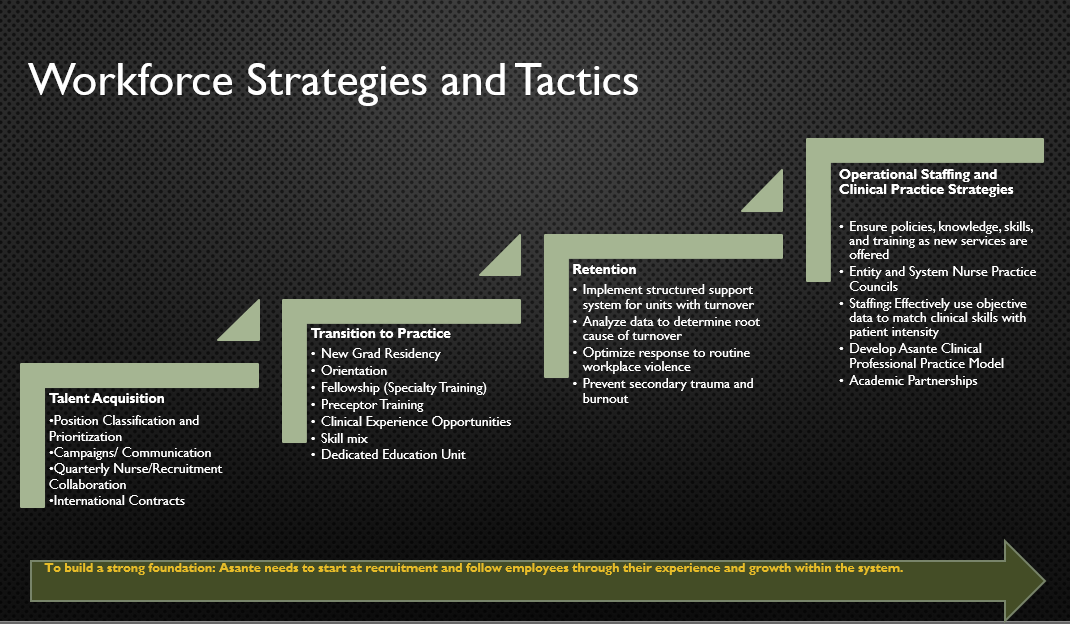Share:
Solving our clinical workforce crisis
We have all read the headlines and feel the burden of clinician staffing shortages. The Oregon Center for Nursing identifies turnover among the nursing workforce as a “global issues with a significant impact of the delivery of high quality care and financial performance of health care systems.”
As of Dec. 3, Asante has 926 total open positions, or a vacancy rate of 13.7%. More than 400 of these are for nursing or CNA positions.
An organization’s workforce is critical to delivering safe, high-quality care and a good patient experience. That said, this is an incredibly challenging time to recruit and retain staff. Asante is not alone in these challenges.
We need to ensure staffing to accommodate:
- Surges of COVID and non-COVID patients within existing care units.
- Surges of COVID and non-COVID patients within surge locations.
- The impacts of exposure, quarantine, ETO and other sources of absenteeism.
- The impacts of vaccine mandate transitions.
- The impact of planned expansions.
Asante is working hard to recruit, onboard and retain members of the clinical workforce. Through workforce planning, we can build an engaged workforce of the right size, with the right skills and diversity, organized in the right way to deliver the services needed to achieve the best patient outcomes. Given our current challenges, this requires short-, medium- and long-term planning as well as a team effort.
Here are some of the things we are doing:
Recruiting
Asante’s Talent Acquisition team has been focused on filling our many open clinical positions using a variety of tactics, including billboards, social media advertising, videos featuring nursing staff and employee referral bonuses than can fetch up to $2,000 for any employee whose referral results in a hire.
Asante’s career website is in the final stage of redesign for nursing-specific content, so be sure to check out the new page in the coming months.
See Asante’s systemwide recruitment strategies »
New-graduate registered nurses
New-graduate RN residency applications are open for the March 2022 cohort and active recruitment is underway locally and nationally. Asante’s Talent Acquisition Team and nursing leaders meet with soon-to-graduate nursing classes to share about the new-graduate residency program and Asante. Virtual meet-and-greet sessions are offered for prospective new graduates and hires to learn about Asante and meet leaders. Asante continues to offer student rotations and integrative practicum placements for nursing students.
The CNA workforce expands
In August, the Oregon State Board of Nursing updated authorized duties for CNA1. In response, Asante added the CNA1 role to the workforce, with a focus on placing these CNAs in medical surgical units across the organization. Asante Talent Acquisition and nursing leaders attend local CNA training cohorts to share about Asante and offer incentives and scholarships for those who apply for and later obtain a CNA certification.
To support clinical staff in understanding the difference between CNA1 and 2 authorized duties, a new Asante guideline, Training and Authorized Duty Guidelines for Certified Nursing Assistants![]() , is posted on myAsanteNET.
, is posted on myAsanteNET.
To support onboarding and orientation of all CNAs, Nursing Professional Development has a new-hire CNA skills training class offered during new-employee orientation. The first session begins Dec. 9.
The skills training class is intended to meet the requirements for CNA1 additional skills training as outlined by the OSBN. It provides the opportunity to learn and practice skills according to Asante policy and procedure and prepares the CNA to confidently demonstrate skills with their preceptor in the patient care environment. The CNA skills training class will take place Thursdays of each NEO week through 2022.
Travelers and contract staff
To fill in for staffing needs, Asante has reallocated clinical staff, rehired or hired local RNs and relief nurses, and increased the number of travelers to meet capacity demands. Asante has onboarded more than 300 travelers since August 2020, and leaders continue to assess the individual staffing needs at the unit and system level.
International nurse travelers
Next year, Asante will partner with the international travel company PassportUSA, which specializes in finding international nurses. It takes up to 18 months to place international nurses within an organization and contracts are typically three years.
Potential candidates have a minimum of two years’ nursing experience, are interviewed for fit, have extensive prearrival training and support during transition to the community, and are integrated into the Asante community similarly to new-graduate RNs. More to come on this exciting new pipeline to our organization!
New care models
We’re working differently to make the most of our resources. This includes developing new care models, enhancing our skills and adopting team-based nursing practices.
Team-based nursing guidelines![]() are helping us address staffing shortages, floating and variable levels of experience. Staff provided additional training and support to care for new patient populations. Likewise, skills assessments (critical care
are helping us address staffing shortages, floating and variable levels of experience. Staff provided additional training and support to care for new patient populations. Likewise, skills assessments (critical care![]() and medical surgical
and medical surgical![]() ) are helping staff clearly identify their skills and provide a fast way to communicate about how they can best support the team.
) are helping staff clearly identify their skills and provide a fast way to communicate about how they can best support the team.
Preceptor training
Asante preceptors![]() are a critical component to successfully onboarding and retaining travel nurses and new hires. To ensure preceptors have the right knowledge and skills, Asante offers regularly scheduled preceptor training, which can be found in the ALEC/HealthStream course catalog.
are a critical component to successfully onboarding and retaining travel nurses and new hires. To ensure preceptors have the right knowledge and skills, Asante offers regularly scheduled preceptor training, which can be found in the ALEC/HealthStream course catalog.
Newly identified preceptors should attend training; preceptor training is required a minimum of every three years. Preceptor training lays the foundation for optimal coaching, mentoring and communications skills, and gives preceptors checklist completion privileges in ALEC. Thank you to those of you who are regular preceptors!
Administrative strategies
In addition to the workforce strategies, administrative strategies are also in place to support staff. These strategies include premium pay, such as ESP and VSP, posting open positions to achieve maximum staffing, variable-position staffing, benchmarking, and workload and intensity measurement.
Our workforce is the infrastructure that makes Asante a great place to work. This is an incredibly challenging time to be in health care and the work you do every day does not go unnoticed. Your ongoing input is essential to continue to help develop the awesome nurses and clinical staff that make this a great place to work. Please share any unit, facility, or system-level recruitment, training or care model ideas with your leadership team!
If you have a question, please contact the author or relevant department directly.




